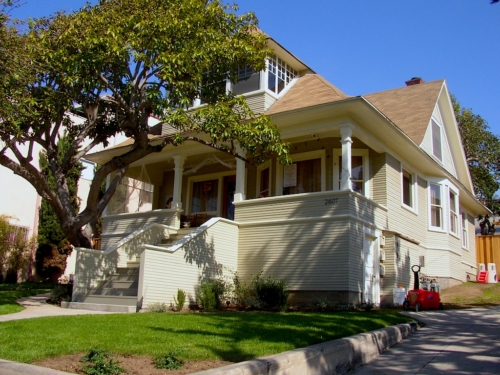2607-2609 Third Street

- Known As
- Third Street Neighborhood Historic District, Victorian, Craftsman
- Architect
- Unknown
- Built
- 1905
- Designated
- 1990
The steep cross-gable roof, narrow clapboard siding, bay window under the front porch, recessed front porch and boxed (closed) eaves are all Victorian architectural features. This house is characteristic of the late phase of the Victorian with the use of simpler forms and less ornamentation, as well as the boxy proportions, which anticipate the Craftsman style emerging at the time it was built. The port columns are squared, a treatment found in Craftsman homes, but their slenderness and detailing links them with the Victorian.
When purchased by the current owners in 1997, the house suffered badly from decades of neglect and deterioration. It had been subdivided into two units, upper and lower, and had been a rooming house in the 1940s.
Consequently, the approach to rehabilitating this house was to remove much of the interior and rebuild. However, the owners were committed to reconstruction that would replicate its original style and detailing, and used recycled original materials whenever possible. For example, floorboards downstairs were salvaged from the original and re-laid. Upstairs, new floorboards were laid that were the same type of wood with the same visual qualities as the originals.
The house was elevated off the ground to construct a new foundation and a concrete basement used for storage. The exterior has been restored, and the only change was to enlarge a dormer on the south side to increase interior bedroom space. This dormer matches the original one on the north. The chimney was rebuilt to code and was refaced with the original brick from the old chimney that was cut to make a veneer.
The interior staircase is in a different location from the original to accommodate an altered interior plan. However, the staircase posts replicate those found on the porch. The fireplace wall remains from the original house, as does the area behind the kitchen. Other architectural features, such as the wainscot, picture rail, windows and window framing, are exact replications of the original historic materials, all custom-made for this house. Hardware and light fixtures are either salvage or replicas that were purchased to restore historic authenticity. The bathrooms also use tile and futures recreating the period flavor.
This beautiful historic home combines exterior restoration with interior reconstruction to recreate as authentic a historic interior as possible.
Sources:
- Photo courtesy of Benjamin L. Ariff